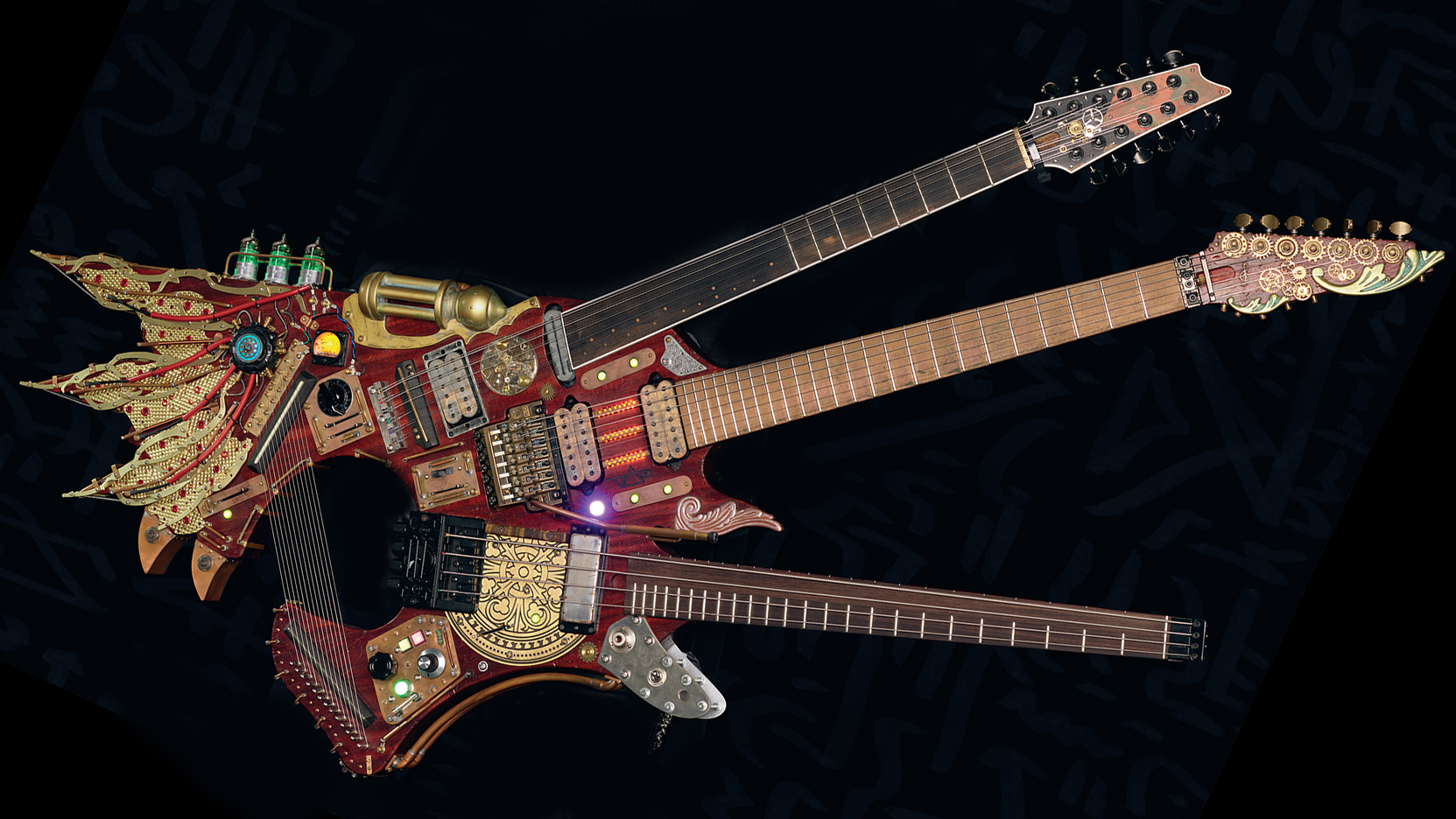Steve Vai: “Joe Satriani has an ear like none other. When I was a kid he would say, ‘No, don’t vibrate it out of tune. You’ll sound like an idiot!’”
The maestro of instrumental guitar discusses new album Inviolate, the relentless pursuit of new techniques and sounds, and the enduring inspiration of his friend Joe Satriani

Steve Vai is in his happy place. Literally and physically that is the Harmony Hut, base camp for his audio adventures, where “enthusiasm makes the time disappear” as he tunnels deeper into his appreciation of the electric guitar.
He joins us from the Harmony Hut via Zoom, a familiar framing for the conversation, with his mixing desk glowing softly in blue in the background. But Vai’s happy place is also a state of mind, and it can be found in the afterglow of discovery.
He has enjoyed his share of discoveries over the years, working with Carvin, Synergy, Morley, DiMarzio, and most notably Ibanez with whom he developed the JEM, Universe, PIA, and of course the striking triple-necked Hydra that presented musical opportunities the likes of which Vai could scarcely dream of until he finally plugged the steampunk-inspired hybrid electric in and learned to play it.
The satisfaction in bringing the Hydra to heel moved him to tears, and it gave him the sounds and inspiration to write Teeth Of The Hydra, the opening track to his 10th studio album, Inviolate. Those are the most profound discoveries for Vai; new ideas and techniques, a challenge to overcome and ultimately a sound he hasn’t heard before. Those are the experiences that keep him at the instrument.
“Satisfaction is addictive,” he says. “My style was accidental and innocent, because I sat there and thought, ‘I like this. As a matter of fact, I really like this. Okay, here’s a challenge…’ And then you complete the challenge and it is an opportunity for you. That’s the way it was in teenage Steve’s mind. Can’t do it, but wanna do it… ‘Oh, there it is. Oh my God! I can do it.’ That is all I ever needed, and that was all I ever had.”
This pattern of challenge then opportunity set the table for a recording career that has taken Vai from tutelage under Joe Satriani to stunt guitar foil for Frank Zappa, playing with David Lee Roth, starring in the movie Crossroads, Whitesnake, and then becoming one of guitar’s most respected and adventurous solo artists.
“Everything came as a consequence of that,” he explains. “I didn’t ask Frank to be in his band, he asked me. I didn’t ask Crossroads. They found me. David Lee Roth found me. My record deals, they came to me. Of course I put my radar out but the challenge for me was, ‘Who do I go with: D’Addario or Ernie Ball?’ That’s a challenge, a good challenge!”
Want all the hottest music and gear news, reviews, deals, features and more, direct to your inbox? Sign up here.

The story of Inviolate is very Steve Vai; it’s all about alien sounds and quicksilver arrangements that came together through challenge and opportunity. Injured with his arm in a sling, he put his legato chops to work and wrote Knappsack, an idea that he describes as “low-hanging fruit.”
The technique of joint-shifting was a challenge yet it yielded, finally, and gave him Candle Power, a track performed with the unerring rigour of an algorithm but an extravagance that is trademark Vai.
Playing the Hydra? That was a big one. He plays rehearsal footage over the video connection and it’s striking how smooth his movements have to be as he moves from neck to neck and keeps the song airborne. The Hydra’s complex terrain took a lot of time.
A lot of these techniques take time. In an hour-long conversation, that’s the only limitation that Vai acknowledges. Not even he can cheat time. The rest, however, is up for grabs.
There are limitations to the guitar in terms of the frequencies we can play with but what you do is challenge what we think is possible from them – even on a micro level, your legato gives it a woodwind quality. Is that deliberate, that sense of challenging the guitar?
“I have been very fortunate in life because I discovered something I really enjoy. When a person enjoys something that they enjoy doing, in any field, and they stick with it, it’s inevitable that they are going to evolve their own world in it. Their world is going to evolve and it is going to constantly change. You can’t go backwards. The idea of going back is actually insane. As you go forward, you are gaining experience.
I always look for situations that are challenging. Some are harder than others, but challenging situations where I can ask myself, ‘How can this serve me? How can I make lemonade out of lemons?’
“When you give your focus to something constantly, you are going to go deeper and deeper, and I think that what you are pointing out is an evolution of a particularly way that I play that was brought on by various situations. For instance, I always liked legato. I was a big Allan Holdsworth fan. I just liked that, like you were saying, that woodwind kind of a sound.
“And I always look for situations that are challenging. Some are harder than others, but challenging situations where I can ask myself, ‘How can this serve me? How can I make lemonade out of lemons?’ So, when they said, ‘Lockdown!’ I said, ‘Okay, how can that serve me?’ Candle Power, Under It All, Sandman Cloud Mist, Knappsack, that all came out of lockdown. That’s how it served me.”
You played on through injury. It’s difficult to get you away from the guitar.
“When I got home from the hospital, the second day, I picked up my guitar and there was no challenge involved in the idea; the idea was low-hanging fruit. I’m going to write this song with one hand!”
When people saw Knappsack, where I am playing with one hand all over the place, ‘Oh my God! It’s crazy!’ Nah, it’s simple
Sometimes the low-hanging fruit can be the hardest thing to recognise from a creative perspective. We look too hard for ideas. We undervalue some ideas because they feel too easy.
“Exactly! That it is an incredibly powerful point, because everything that I have done that has been worth its salt has always came with an innocent ease. It was a recognition of the low-hanging fruit. So, when people saw Knappsack, where I am playing with one hand all over the place, ‘Oh my God! It’s crazy!’ Nah, it’s simple.
“The idea, I am sitting there, and I’m playing, and I only had one hand, and it was just low-hanging fruit. And the low-hanging fruit said, ‘You can write a song with one hand.’ So, I did it. And that was a simple recognition, just like what you were pointing out.
“That low-hanging fruit exists in everybody when they look for it and those are the perfect creative ideas that the universe is feeding specifically for their own unique ability to exploit that idea. Somebody else who is a sports figure is not going to get an idea to record a song with one hand, y’know! [Laughs]”

This technique of joint-shifting and how you used it on Candle Power does not seem like low-hanging fruit. The execution of it is quite something, like pedal-steel country for an anime show. It has this almost programmed quality.
“Well, thank you for that. Candle Power, many years ago, I had this visualisation, audible and visual, and being a guitar player you learn the real estate of the instrument, and you start thinking outside of the box.
I will have to work very hard just to play Candle Power, but in my mind’s eye I can see and hear a piece of music that sounds so different you will not believe it. It’s all joint-shifting and more
“I just thought, ‘What would happen if I had a guitar that had a solid bridge?’ Because if you have a bridge that moves, like with a whammy bar, joint-shifting is impossible. And if I was to bend notes in different directions while using open strings and hammers and crawling up the neck? That was a vision. I had no idea what it was going to be but I knew in my mind’s ear it was going to sound unique and quirky, and obtuse and interesting, and it was going to look as freaky as shit!
“That was low-hanging fruit, brother. Here’s the thing, whenever you get an idea like that, specifically given to you from the universe, it comes with the feeling of enthusiasm, and when you follow that feeling of enthusiasm it is low-hanging fruit. It is innocent. You find yourself doing it because it is enjoyable.
“‘Steve Vai, he’s got Grammys, he’s got number one records, he’s got all this stuff… He’s so lucky. He’s got it all!’ You know what tickles me the most? [Wiggles fingers] And going, ‘Holy shit! It worked! It worked better than I thought, and it sounds more obtuse than I could have imagined.”
And that is where you find the pleasure? The satisfaction in acquiring a new technique.
“Other people can criticise [joint-shifting] but I’m fucking blown away! ‘Holy shit! I’m doing this!’ That’s joy. I’m allowed to feel that. There’s no arrogance in that. There’s an incredible appreciation. Here’s the kicker: when I thought of it, I knew I could do it if I got the time in.
“I did not believe I could do it. If I believed I could do it I would be going, ‘I believe I could do it but I don’t know.’ That is what a belief is. But you don’t know. There’s something different inside of you when you are harbouring a belief or when you are harbouring a knowing. A knowing has no belief in it; it’s like, ‘I know I can do that.’ I just put the time in. And if I can’t do it, it’s because I can’t put the time in.
“But the enthusiasm makes the time disappear. It stands still. That’s how you make time stand still; you give something your full attention, then you pick your head up and it’s three hours later. I picked my head up and it was three weeks later and I only got those two parts of the song that do the joint-shifting because it was so difficult.”

But now you have this technique, presumably there will be applications for it, more musical ideas. Other people can step up and use it.
“One of the things that we do creatively is create a landscape for new people to come along and be newly inspired and then take it from there. Because when I thought of joint-shifting, and you asked me if I was going to do more of that, in order to prepare for the tour I will have to work very hard just to play Candle Power, but in my mind’s eye I can see and hear a piece of music that sounds so different you will not believe it. It’s all joint-shifting and more.
I have these weird techniques! I hear it, and I know I can do it, but I don’t have the time. It’s going to take younger fingers and time
“I have these weird techniques! I hear it, and I know I can do it, but I don’t have the time. It’s going to take younger fingers and time. I try to contribute inspiration for kids to take it further because it’s a treasure. The joint-shifting thing is a treasure. You hear people say, ‘It’s a country technique everybody’s been doing…’ Fine. I don’t care. You saw me doing it that way, take it someplace else, because I took it somewhere different. Now it’s your turn. I want to see it. I want to live to see that.”
We are all standing on shoulders of giants. And yes, it could apply to country. Candle Power is like Dwight Yoakim from the Andromeda system. Players can take this and apply it in all kinds of different contexts. You can.
“Can you even imagine? I wanna do it so bad. Maybe I will. I do a little bit of it on Greenish Blues.”
You will, because it is part of your vocabulary now.
“It is, and that’s a great way of putting it. It’s your vocabulary.”
You also had a new instrument to learn in the Hydra. And then, of course, there is a big difference in being able to play a piece of music and being able to perform it.
“You’re exactly correct, and that was a real challenge for me, because the Hydra introduces some real limitations. It’s heavy. I recorded the song and learned everything when it was on a stand, because I just couldn’t hold it long enough, but Thomas Nordegg, my guitar tech, created this strap that holds the guitar and puts the weight on my waist.
“Now you mention the performance, in my mind’s eye, I was thinking, ‘Okay, I have to get it to where I can navigate with this instrument freely onstage and not make any mistakes. I know I can do it, but it’s going to take a lot of time.’ Essentially, I am just about there.”
Can you not just use it with the stand onstage. The very act of playing it onstage is spectacle enough.
“I think so. Actually, Joe Satriani said the same thing to me, and I have decided as such that I will probably perform this with the stand. Because it is risky.”
Well, I endorse that approach. It’s funny how you both like to make things difficult for yourselves…
Joe Satriani has an ear like none other. When I was a kid, he would say, ‘No, don’t vibrate it out of tune! You’ll sound like an idiot!’ When I was 13 years old! And I said, ‘Okay, I will never vibrate a note ever out of tune for the rest of my life’
“We enjoy it though! What’s similar between Joe and I is that we were fortunate to discover something we really love when were young, and we just never stopped focusing on it. And you expand on it. We have a bit of a different voice, very different, but we have supported each other so much. I wouldn’t be anything, what I am today without Joe just being there – and many others. Without Jimmy Page just being there, Jimi Hendrix…
“But Joe more than anyone else, for me, and it is just so nice that over the years we have been able to work together and we’re still like brothers. And we’re still trying to figure out ways of getting on tours together. His new record? Oh my God! It is so Satriani. It’s that expansion of melody and tone, and all of the things that you love about him. Inviolate is that artist making that next step, and those who are attracted to what I do see that as well.”
It’s fascinating that you have both made these records out at the same time and that are so indicative of where you are coming from artistically. It is great for us to look at them critically and appreciate the differences in your styles. You’ve both got a similar sensibility, a way of seeing the instrument, but how you do it is different.
“Joe is a class act, and his musical sensibilities are inspired. He has an ear like none other, and he is very precise and specific, and that has served me so well in my life. When I was a kid, he’d say, ‘No, don’t vibrate it out of tune! You’ll sound…’ Actually, I remember him saying, ‘You’ll sound like an idiot!’ When I was 13 years old! And I said, ‘Okay, I will never vibrate a note ever out of tune for the rest of my life.’”
He is Mr Intonation.
“I know! I couldn’t believe his intonation. It’s stunning.”

“What’s of absolute importance is the quality of your inspiration. Everything else comes from that”
Going back to electric guitar design, it is funny, because this is a 20th century technology, playing through 19th-century technologies like vacuum tubes, it’s quite steampunk in its own right.
“I see various things going on. There’s a part of me that looks into the world and sees what’s available: ‘Where is technology and how can it serve me, and what guitars are available and what can they do?’
“And I remember, early on, thinking, ‘This is a Stratocaster, okay, it’s got a whammy bar, which is what I want. I don’t like the way it sounds because it has single-coils. Now there’s the Les Paul; that’s what I want. That’s what Jimmy Page plays. It sounds great. It sounds rock ’n’ roll. But it doesn’t have a whammy bar. It doesn’t have enough frets. It doesn’t sit well.’
When you are doing things innocently, it’s not like you feel like you are being blasphemous. Like it’s blasphemous to put a whammy bar on a Les Paul? Fuck you! I’ll do what I want!
“Then I am working with Frank Zappa and watching what a free-thinker he is, and he had no governor. When it came to taking a guitar that Jimi Hendrix burned at a concert, that Frank got ahold of, and then putting parametric EQs in it? It didn’t matter whose guitar it was, it looked cool.
“So, I decided at one point, and this was simple, innocent, low-hanging fruit, not having any intention of making something that anybody else would be interested in except myself, and what that was was the JEM.”

That's the key. Doing what you want with no regard to what anyone else is thinking.
“I looked around and went, ‘What do I want? What’s not here? I want 24 frets with double-coil pickups. I want that.’ It didn’t exist, y’know. I wanted to be able to reach those frets! That didn’t exist. You can’t reach them on a Strat or a Les Paul. They make these cutaways so you can’t play comfortably up high.
“When you are doing things innocently, it’s not like you feel like you are being blasphemous. It’s blasphemous to put a whammy bar on a Les Paul? Fuck you! I’ll do what I want! Y’know, I am going to do what I want because it doesn’t matter to anybody, see? That makes it easy. When it doesn’t matter to anybody else but you, it’s really easy.”
I designed the JEM to my little idiosyncrasies, and when I started playing it I thought, ‘Yes, this it. This is the guitar. It’s perfect. It is perfect for me’
Even so, Frank Zappa really modded Hendrix’s Strat?
“Yeah! He had these double-stacked parametric EQs. And he put a Floyd Rose on it… [Laughs] Y’know! He took the pickups out! He changed the pickup covers that had the stuff Hendrix used, the lighter fluid. It had the pickup covers that had the holes from the lighter fluid. ‘Take them out and change them!’ [Laughs]”
It’s such a Frank Zappa thing to do.
“I know! But Dweezil got it all back together. Frank didn’t throw this shit out. From what I understand it was a guitar that Jimi burned in Miami.”
Incredible. There should be nothing sacred when it comes to art. It’s freeing.
“Yes, yes! [Especially] when you are sitting there thinking that you are doing doesn’t matter to anybody. I designed the JEM to my little idiosyncrasies, and when I started playing it I thought, ‘Yes, this it. This is the guitar. It’s perfect. It is perfect for me.’ And it didn’t exist in the world.”
You have made this record to be very much like a Side A / Side B release. The sequencing would suggest so – and this is something Mr Satriani did as well on his new on. Was the vinyl release on your mind when you sequenced the record? And is that the perfect form for your music, analogue, on vinyl?
“I know what you’re saying, yeah. If people could sit in that chair [at the Harmony Hut] and hear the digital version of Inviolate and then hear the analogue version, it would become very clear to them what is going on.
“So, here’s my best explanation: I like to preserve the analogue domain as much as I can, for the vinyl, because that is what the vinyl enthusiasts are looking for. In the past, all of my records that were recorded on analogue, were analogue, analogue, analogue; it goes from 24 track to two-track, to vinyl. So, it doesn’t get processed digitally. That’s the most authentic analogue sound.
“With something like Inviolate, I did not record it on analogue. I haven’t done that for years. But it is recorded on high-quality with great convertors – the best. We found the convertors that we liked and then recorded digital, but when I was mixing Inviolate, I did one mix to digital, and then I did one mix directly to analogue, so when you take that analogue, that analogue tape, the two-track, then goes to get mastered completely differently to the digital.”
And you notice the difference?
“I had Bernie Grundman master it. Bernie Grundman is the most-renowned analogue record maker in history. He’s been doing it since before I was born. So, when you listen to the digital version, and you are an engineer, you understand its limitations.
“When you slam digital meters it creates a distortion that is very unpleasant. It’s got spikes and pops and razor-edges. When you slam analogue, because it is magnetic tape, it compresses, and it warms it up, so a slammed analogue – and I am not talking destroying it here, going many dBs above the limit – you are getting the full signal that is being fed.
“Although the source was a digital source, it didn’t have to go through analogue to digital conversions millions of times, and this is when you can relieve the recording of a lot of hash, a lot of that digital hash that you don’t realise is so annoying to you.
“It actually makes you feel different, and this was a study that was done, that Bernie actually told me about, where they took a group of people and they played them music from vinyl that was pure analogue, and the same music on digital, and the people who were exposed only to the digital had more of an aggressive kind of an attitude or feeling – much more!”

Maybe all the digital noise that's out there is what's making everybody so angry.
“When I was mixing Inviolate, when I am mixing anything that’s pure digital, there is a part of me that is enjoying the music, that’s listening for EQs and stuff like that. But there is part of me that says, ‘This absolutely sucks.’ I hear the digital in it. I know we can’t get rid of it because it’s digital, it’s there, it’s unnoticeable to many who aren’t listening for it… That’s why I said, ‘If you are sitting in that chair’. I put the record on and the analogue is like [sighs]. It has this warmth. The top end is completely different. It is just different.”
Sure, but digital is a fact of life and it does bring with it some benefits. Like we spoke about earlier on, maybe we just have to choose not to let it bother us.
“Yeah, you forgive it! You bypass it.”
- Inviolate is out now on CD, vinyl and digital via Favored Nations / Mascot Label Group.
Jonathan Horsley has been writing about guitars and guitar culture since 2005, playing them since 1990, and regularly contributes to MusicRadar, Total Guitar and Guitar World. He uses Jazz III nylon picks, 10s during the week, 9s at the weekend, and shamefully still struggles with rhythm figure one of Van Halen’s Panama.
